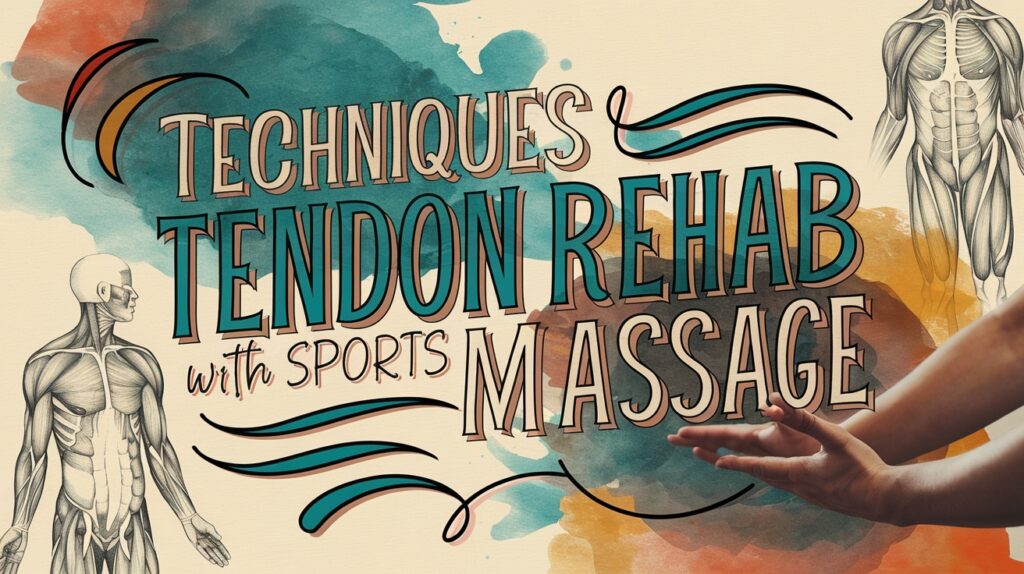You’ll find several effective sports massage techniques for tendon rehabilitation, including cross-fiber friction and deep tissue release methods. Begin with gentle strokes during the inflammation phase (3-5 days post-injury), then progress to deeper pressure as healing advances. Use specialized tools like IASTM instruments and compression devices while applying pressure perpendicular to affected fibers for 3-5 minutes. Following evidence-based massage protocols through each healing phase guarantees peak recovery and performance outcomes.
Understanding Tendon Injury and Recovery Phases
When a tendon sustains an injury, it typically progresses through distinct healing phases that require specific therapeutic approaches. You’ll notice the first phase, inflammation, occurs immediately after injury and lasts 3-5 days, during which you’ll experience swelling, redness, and pain. The second phase, proliferation, begins around day 5 and continues for several weeks as your body creates new collagen fibers to repair the damaged tissue. During the final remodeling phase, which can last months to a year, you’ll need to focus on proper alignment of these new fibers through controlled loading and movement. Understanding these phases helps you determine when it’s appropriate to apply specific massage techniques and exercise progressions to support ideal healing. Incorporating evidence-based guides can further enhance your rehabilitation process by providing specific strategies tailored to each phase.
Essential Sports Massage Tools and Equipment
With proper healing phases established, you’ll need specific tools to effectively support tendon rehabilitation through sports massage. Professional-grade massage tools and equipment can enhance your therapeutic approach, providing targeted pressure and manipulation for ideal healing results.
- Core Manual Tools
- Massage cream or oil
- Thumb and finger compression tools
- Cross-fiber friction devices
- Myofascial Release Equipment
- Foam rollers (various densities)
- Massage balls
- Compression bands
- Advanced Therapy Tools
- IASTM (Instrument Assisted Soft Tissue Mobilization) tools
- Cupping sets
- Percussion massage devices
You’ll find these tools particularly useful when addressing different stages of tendon rehabilitation, as each serves a specific purpose in promoting tissue repair and maintaining proper alignment during the healing process. Moreover, utilizing effective tools for maximizing movement can significantly enhance rehabilitation outcomes.
Cross-Fiber Friction Massage Techniques
Cross-fiber friction massage stands as a cornerstone technique in tendon rehabilitation, requiring precise application perpendicular to the affected tendon fibers. You’ll need to locate the exact area of tenderness and apply direct pressure with your thumb or fingertips, moving across the tendon’s width rather than along its length.
When performing this technique, you’ll want to maintain consistent pressure while moving back and forth for 3-5 minutes. It’s essential to work at a depth that’s therapeutic but not excessive, as you don’t want to cause additional inflammation. You should position the tendon in a slightly stretched position during treatment, and if you’re working on the Achilles or patellar tendons, you’ll need to verify the client’s leg is properly supported for ideal results. Additionally, incorporating sports massage into the rehabilitation process can significantly enhance recovery time and performance.
Deep Tissue Release Methods for Tendons
Deep tissue release for tendons builds upon friction techniques by incorporating sustained pressure and targeted manipulation of deeper musculotendinous structures. You’ll need to apply methodical pressure while monitoring tissue response and client feedback to effectively release adhesions and restore proper tendon function.
- Position your thumb or elbow at a 45-degree angle to the tendon’s fiber direction, applying sustained pressure for 30-45 seconds while the tissue gradually yields
- Work systematically along the tendon’s length, paying special attention to areas where you detect thickening or irregularities in tissue texture
- Combine deep pressure with gentle stretching movements to enhance tissue mobility and reduce restrictions between tendon layers
When you’re working with deep tissue methods, you’ll need to maintain clear communication with your client to guarantee the pressure remains therapeutic rather than excessive.
Progressive Loading Through Massage Therapy
As tendon rehabilitation progresses through massage therapy, integrating graduated loading techniques becomes essential for best tissue recovery and strengthening. You’ll need to apply progressively increasing pressure during your massage sessions, starting with gentle strokes and gradually advancing to deeper manipulation as the tendon’s tolerance improves.
You can begin with light cross-fiber friction techniques, working at 25% intensity for 2-3 minutes, then incrementally increase the pressure over subsequent sessions. As you advance, you’ll incorporate longer duration holds and deeper strokes, matching the tendon’s growing resilience. Monitor tissue response through both objective measures, such as range of motion, and subjective feedback from your client. This systematic progression helps prevent re-injury while promoting best collagen alignment and enhanced blood flow to the healing tendon.
Real-World Case Studies of Tendon Rehabilitation
Real-world examples demonstrate the remarkable outcomes of progressive tendon rehabilitation through sports massage. You’ll find that documented cases consistently show improved recovery times and enhanced healing when combining targeted massage with structured exercise protocols. Clinical evidence supports the effectiveness of this integrated approach for various tendon injuries.
- A professional athlete’s Achilles tendinopathy showed 85% improvement within 12 weeks using deep friction massage and gradual loading.
- Tennis elbow patients experienced 73% pain reduction after eight weeks of cross-fiber massage combined with eccentric exercises.
- Patellar tendon cases demonstrated 70% faster return-to-sport timelines when incorporating both sports massage and progressive loading techniques.
These results highlight the significance of incorporating massage therapy into thorough tendon rehabilitation programs, particularly for athletes seeking ideal recovery outcomes.


